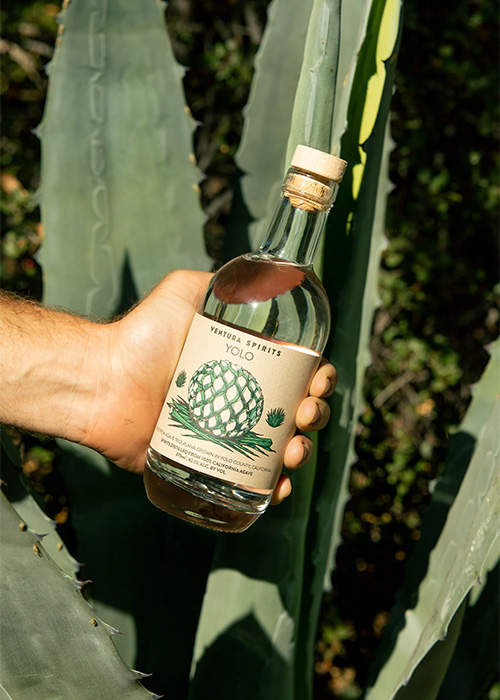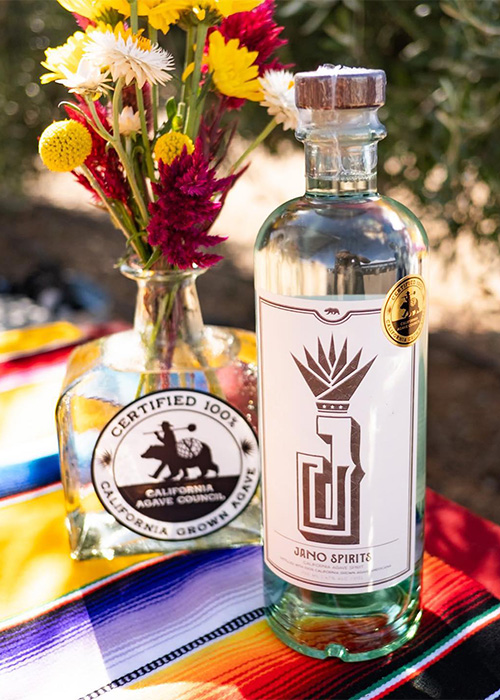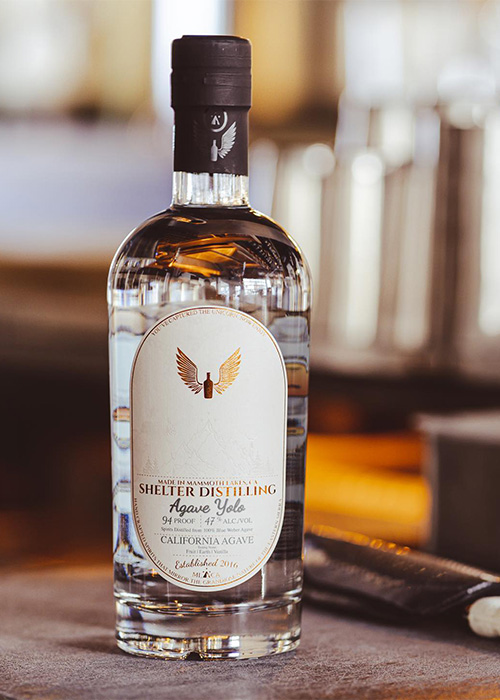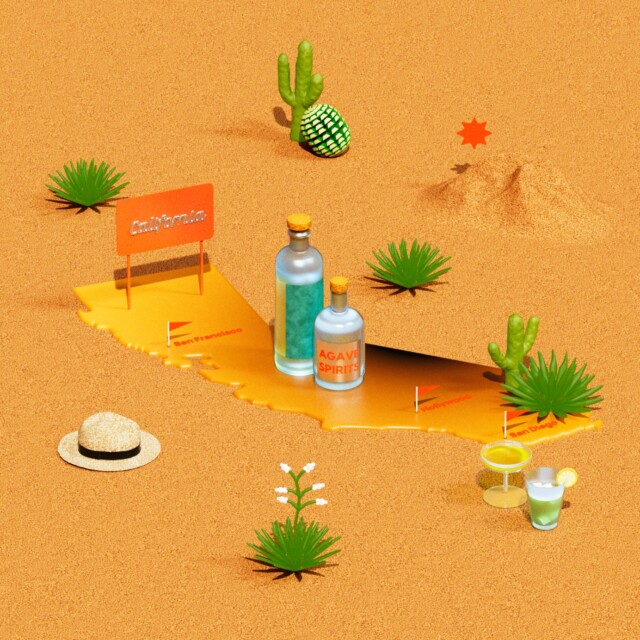Two days after listing their craft agave spirit, Rancho del Sol, for sale online, the leaders at Shelter Distilling in Mammoth Lakes, Calif. started to sweat a little. “We have to take this thing down and stop selling,” they told themselves. There was a Margarita festival the next day. And the distillery was perilously close to running out of bottles.
That particular spirit — made from six agave varieties, all grown in California — was special. The price said as much: “We were like, ‘Oh gosh, who’s going to spend $150 for a bottle?” says Patty Swenson, Shelter’s executive chairwoman. “Apparently, a lot.”
If the 90-bottle run was a little anxiety-inducing, it was also a sign of an emerging, enthusiastic — albeit niche — market for California agave spirits. Tequila and mezcal from Mexico, of course, already have a massive foothold in the agave spirit market. According to the Distilled Spirits Council of the U.S., there’s been a 273 percent volume sales increase of tequila and mezcal stateside since 2003.
But in an arid landscape similar to Mexico’s agave-spirits-producing region, California can grow the base material, too. So a plucky group of distillers and growers in the state are betting on establishing their own foothold in agave spirits.
“That’s kind of the gamble a lot of us are taking in this industry,” says Gian Pablo Nelson, co-founder of Jano Spirits. “Tequila’s hot right now — tequila’s here to stay. People love the product but do they love California agave? We’re willing to put in the risk to make that happen.”
Now the question is: Can these pioneering producers win the bet, especially with such a niche product? And is this category viable — financially and logistically?
The Hurdles to a Scaled Industry
Part of succeeding on those fronts involves not just distilling but communicating the story behind these spirits. If domestic agave distillates are to compete against heavy hitters, customer education and connection are key.
“It’s not just a random bottle off the shelf,” says Matt Hammer, Shelter co-founder. “It’s a passion project — from a small farm in California, to an ax and two-by-four, to this incredible product.”
Ax and two-by-four, you might be questioning?
Put that thought on ice for a second. Aspiring distillers have a bigger, more pressing barrier to scaling production: the plant itself.
Agave is one of the most labor-intensive products a distiller can process. Plants can grow several feet tall depending on the species and are characterized by giant, spiky leaves. Wrestling these beasts into submission can take some ingenuity — especially in the U.S., where distillers don’t typically have large-scale agave processing equipment as in Mexico.
Nestled in the middle of the spikes is the heart, or “piña,” which holds the juice and fermentable sugars distillers need. For extraction, a piña (which can weigh up to 200 pounds) has to be quartered into smaller pieces, roasted, then eventually shredded.

For some California distillers, that’s meant using hatchets and two-by-fours with jerry-rigged handles to whack the piña into manageable pieces. After cooking or roasting those pieces, they get fed into equipment capable of shredding them. Nelson used a landscaping-style wood chipper at first; Shelter still uses a wood chipper. Ventura Spirits, which makes an agave spirit dubbed “Yolo,” after the county from which the agave was harvested, uses an old, customized hammer mill.
It’s a far cry from distilling wheat or barley, the more established pillars of American spirits. “A grain is the size of a pea, while the piña is a large piece of material — so it completely changes what most distillers currently do,” says Sean Venus, CEO and founder of Venus Spirits in Santa Cruz, which makes a California agave spirit called El Ladrón.
The agave plant — which serves as a literal barrier, often in highway medians across California and the Southwest — presents another dilemma.
As things stand today, there simply aren’t enough mature plants throughout California to count on massive harvests. Plants take five to seven years to mature — like waiting on a barrel of whiskey or wine to age, except on the front end of the process.
Right now, distillers mostly rely on forging direct relationships with farmers to secure a harvest. And even that isn’t enough sometimes: Nelson worked with one specific grower for the first two agave spirits Jano produced. But the farm doesn’t have enough mature plants for Jano’s third batch. Nelson is on the hunt for a new supplier and has even taken to knocking on neighbors’ doors if he spots agaves on their land.

“Hey, you have some agave Americana back there,” he’ll say. “Mind if I check it?”
The scramble for supply could change soon, though. According to Craig Reynolds, an agave grower and founder of the California Agave Council, more farmers are looking to transition their acres to more sustainable, less water-guzzling crops. He’s already seen California growers transition almond, pistachio, and avocado acres to agave. With groundwater pumping regulations in California set to become more restrictive over the next few years, that trend could accelerate.
“Farmers are desperate to find a crop that’s profitable and can be grown with a lot less water,” Reynolds says. “It’s kind of the perfect solution.”
For distillers, hitching their wagon to a raw material that will be around for a while feels like a smart idea. And California agave spirits — harvested from parched land, and reliant on ingenuity and creativity to survive — are an accurate reflection of the land from which they came.
“We’re trying to think about, ‘OK, based on where we are in the world, what does it make sense for us to be making?’” says Henry Tarmy, co-founder at Ventura. “Allowing the land to dictate at least in part what goes in the bottle is a very attractive idea.”
Still, even if surplus supply existed today, distillers have some math to figure out. For example, at Venus, the production process of an agave spirit, from harvest to bottling, takes about four weeks. Venus has yielded about 100 cases of agave spirits in six months. By comparison, they can crank through 500 or 600 cases of gin, per month.
Nelson tells a similar story: three or four weeks of processing time for agave spirits, yielding 20 cases (about 240 bottles). In that same span, he estimates about 40 barrels of single-malt whiskey could be produced. At 300 bottles per barrel, that’s 12,000 bottles.
“I don’t think the goal of California agave is to take market share from tequila. I think in the next two to five years, it’s going to become a rare, really specialty product — very experience-based that you search out.”
So if the industry hopes to scale, better equipment and processes are musts. But efficient distillation doesn’t automatically yield a tasty product. That part of the equation has taken plenty of iteration, too.
The California agave spirits industry is in a nascent stage of creativity. While Mexican tequila has to be made with Blue Weber agave, California agave spirits aren’t boxed in by similar restrictions. Like wine grapes, each agave variety has the power to yield a completely distinctive spirit. In other words, at this stage, the American agave industry is practically a playground for distillers who love blending and experimentation.
“We can pretty much take plants from any place in California, in any combination,” Swenson says. “It’s just wide open to experimentation to figure out what grows well in California, and of that, what tastes good.”
What develops in that white space, distillers hope, will appeal to consumers who want a premium product that’s not only delicious but also reflects the uniqueness and diversity of the state.
“I don’t think the goal of California agave is to take market share from tequila,” Hammer says. “I think in the next two to five years, it’s going to become a rare, really specialty product — very experience-based that you search out.”
With the freedom to experiment — to roast or not to roast, for example — California distillers don’t want to just create something that tastes “like tequila.” They hope customers will be drawn to a spirit with its own unique story.
“Look at all these beautiful whiskey traditions from around the world,” Tarmy says. “Kentucky bourbon, Scotch, Japanese whisky, really interesting whiskies coming from lots of other places. It’s not like Japanese whisky somehow cancels out bourbon. They’re both great in their own right and offer more depth and breadth to the category.”
“If you asked us what we think Ventura Spirits is going to look like 10 years from now, there’s going to be a lot of agave spirits.”
Plus, it’s no secret Californian consumers love “local” and “additive-free” labels. Official “California agave spirits” have both, thanks to 2022 legislation that solidified an official designation for the category (products have to be derived from 100 percent agave grown in California, with no flavor or color additives). More conscientious buyers could opt for these spirits over something imported.
“The consumer is wanting high-quality, local products,” Nelson says. “So we can kind of bet that people are going to be supportive of that.”
The (Agave-Spotted) Road Ahead
Pricing California agave spirits is another challenge producers face. With the high cost of agave and the labor and equipment to process it, distillers have to toe the line between covering their costs and pricing a bottle beyond what customers will pay. That $150 bottle from Shelter was at the high end. But they’ve sold other batches for less, and they don’t expect to hit $150 again.

On liquor store shelves, a bottle from Jano will run you about $120. And at $90 a pop, the California agave spirit is the most expensive bottle Venus offers.
“We don’t include it on our cocktail menus because it becomes too expensive to pour,” Venus says. “So it’s about getting that cost reduced down from the super-premium category, into the premium category, maybe selling for $40 to $45 a bottle, or maybe in the low $50s makes it a little more viable.”
Finding a pricing sweet spot could be key to making this spirit category work for distillers — that, and more streamlined processes so they can actually make the stuff.
While there are still big questions to answer, many agree the momentum is higher than it’s ever been for California agave spirits.
Venus says his agave spirits make up less than 1 percent of revenue at his distillery now. But in the next three to four years, he can see that growing to 20 to 30 percent. He already includes his California agave spirit in some specialty cocktail classes and has hopes of that increasing as more customers learn about the category (and taste it).
Down south in Ventura, they see an upward trend line, too: “If you asked us what we think Ventura Spirits is going to look like 10 years from now, there’s going to be a lot of agave spirits,” says co-founder Anthony Caspary.
In Mammoth Lakes, Shelter is moving the bulk of its non-agave spirit production to a new facility in Montrose, Colo. While the brand’s current California location won’t solely distill agave, the category will play a bigger role. Shelter hopes the move will free up more equipment, labor, and space to further hone its agave processes.
As the industry gets more plants in the ground, perfects new recipes, and streamlines production, the hope is to grow a place-driven category true to what makes California unique: from the plants in its dirt, to its melting-pot diversity, to its enthusiasm for experimentation.
To get there, distillers are pushing more chips onto the table — betting on what the industry can be. “You’re never going to find a craft distillery that’s going to close its whiskey operation and make (only) agave,” Nelson says. “But I think what’s going to happen is you’re going to find people that believe in this 120 percent or 200 percent and want to double down on this industry, help get the category beyond our borders of California, and get it to a place where it becomes a namesake.”
This story is a part of VP Pro, our free platform and newsletter for drinks industry professionals, covering wine, beer, liquor, and beyond. Sign up for VP Pro now!
